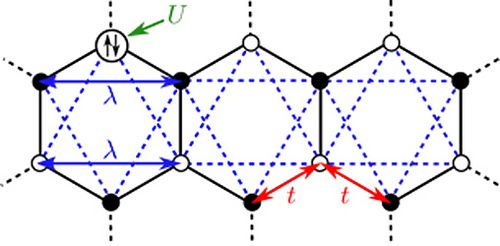MATERIALS SCIENCE AND CHEMISTRY
Simulating Interaction-Driven Magnetism in Graphene
Principal Investigator:
Fakher F. Assaad
Affiliation:
Insitute for Theoretical Physics, University of Würzburg
HPC Platform used:
JUQUEEN of JSC
Date published:
In graphene, a two-dimensional material with remarkable properties, electrons move on a honeycomb lattice and exhibit the same energy-momentum dispersion relation as massless Dirac fermions. Because of the two-dimensional character, the Coulomb interaction between electrons is not screened and leads to a strongly correlated system whose collective properties can be very different from that of individual electrons. The study of such systems has a long and fruitful history, and spans research fields as distinct as high-temperature superconductors and biological systems. Driven by the development of powerful new algorithms and the evolution of computer hardware, numerical simulations on supercomputers have provided important insights into the physics of such systems. The results of such studies are of particular importance for the design of novel materials for technical applications.
With colleagues from Germany and the USA, a team of scientists have used quantum Monte Carlo methods to study a model for graphene that takes into account a local repulsion between electrons, as well as spin-orbit coupling which can give rise to remarkable new states of matter (so-called topological insulators). The Monte Carlo method provides unbiased numerical results and permits the physicists to study the evolution of the system as the interaction becomes stronger. Most importantly, strong repulsion among electrons eventually leads to the onset of long-range magnetic order. By simulating up to 648 interacting electrons on JSC HPC, the scientists have determined the phase boundary and investigated the details of the corresponding magnetic phase transitions. The numerical results are in excellent agreement with theoretical predictions. In particular, the different spin symmetry of the system with and without spin-orbit coupling is directly reflected in the behaviour of physical quantities close to the transition, as described by the critical exponents. In the future, the physicists will generalize their work to a more realistic model that includes a long-ranged Coulomb interaction. The simulations provide exact insights and a basis for further theoretical work on graphene and topological insulators, and will therefore contribute to the ongoing effort to use these novel materials for technological applications in the field of electronics.

The Kane-Mele-Hubbard model describes electrons on the honeycomb lattice with nearest-neighbor hopping t, spin-orbit coupling ?, and an onsite repulsion U between electrons occupying the same lattice site.
© Institute for Theoretical Physics and Astrophysics, University of Würzburg
Full Article in InSiDE magazine
Scientific Contact
Prof. Dr. Fakher F. Assaad
Institute for Theoretical Physics and Astrophysics
University of Würzburg
Am Hubland, D-97074 Würzburg
e-mail: assaad@physik.uni-wuerzburg.de